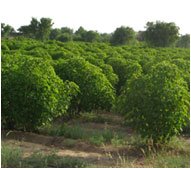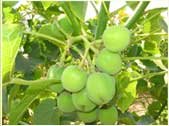The Jatropha Curcas plant is a shrub. It's fruit, the Jatropha Curcas seeds, also called physic nut, is used to produce Jatropha oil, which is used as a component of bio-diesel.
Because of the changing attitudes of Western governments when it comes to the environment, more specifically global warming and the problems the world economy is experiencing, because of the price of petrol and the dangerous situation in a lot of the oil producing countries in the Middle-East, which might have a negative effect on the security of oil supplies, many are looking to promote the use of bio-fuels.
Many governments in Europe, the United States, Brazil and India have made mandatory the use of bio-fuels as part of the total fuel consumption in their countries.
Supply constraints in feedstock for bio-fuel or bio-diesel are a concern, making it a seller’s market for long time to come.
Science has proven that Jatropha is the best bio-fuel alternative.
Brazil is the top maker and exporter of ethanol, a bio-fuel made from sugar cane. Lately more and more farmland is converted to growing the Jatropha plant, which could soon rise as the most popular oil crop in that country.
The United States government has recently raised its allocation for promoting bio-fuels about five times, turning more and more to alternate fuels.
Economically Jatropha has also been proven to be the best bio-fuel alternative, taking into account the cost of growing the crop and extraction and the subsequent oil yield.
The Jatropha plant yields more than four times as much bio-fuel per hectare as soybean, 50% more than what sugarcane yield in ethanol, and more than ten times that of corn.
A hectare of Jatropha produces 1,892 liters of fuel, which is about 6.5 barrels per acre.
The money spent cultivating the Jatropha plant is the most compelling aspect as it is a perennial plant, meaning the fruit grows back year after year, repeated planting of Jatropha is therefor not necessary. Jatropha being a shrub, a half sized tree has a life span of about 50 years. This saves much in cost.
Another advantage Jatropha has over other bio-diesel alternatives is the fact that Jatropha oil is a one-stage conversion to biodiesel, keeping production costs very low.
All in all the Jatropha indutry is projected to surpass the soy-bean boom of the last decade.
Addiotional Information:
Jatropha is a low maintanance crop. Jatropha requires no manure, no irrigation or pesticide as it is not affected by diseases.
Jatropha seedlings yield seeds in the first year after plantation. It has a small gestation period
After the first five years, the typical annual yield of a jatropha tree is 3.5kg of beans.
Jatropha trees are productive for up to 30 to 40 years.
2,200 trees can be planted per hectare, about 1,000 per acre.
1 hectare should yield around 7 tonnes of seeds per year.
The oil pressed from 4kg of seeds is needed to make 1 litre of biodiesel.
91%+ of the oil can be extracted with cold pressing.
1 hectare should yield around 2.2-2.7 tonnes of oil.
After the oil is pressed from the seeds, press cake is left. This can be composted and used as a high grade nitrogen rich organic fertilizer. The remaining oil, which can not be used as bio-fuel can be used to make skin friendly soap.
More Information about the Jatropha Plant
Jatropha fruits are about the size of a grapefruit and four times its weight. Each fruit contains three seeds about the size of a plum. These seeds contain up to 40% oil that when dehydrated can be used as bio-fuel.
As Jatropha also grows on degraded soil and in low rainfall areas Jatropha can also be used to alleviate soil degradation, desertification and deforestation. It can do with a mean annual rainfall of between 300 and 1000mm. More rainfall means higher yield.
In essence Jatropha needs 600mm of rain annually to thrive, however it can survive three years of drought by dropping its leaves.
The Jatropha plant itself a small tree or shrub with smooth gray bark, which exudes a whitish colored, watery, latex when cut.
Normally, it grows between three and five meters in height, but can attain a height of up to eight or ten meters under favourable conditions.
Fruits are produced in winter when the shrub is leafless, or it may produce several crops during the year if soil moisture is good and temperatures are sufficiently high.
The seeds become mature when the capsule changes from green to yellow after two to four months.
The trees are deciduous, shedding the leaves in the dry season.
Flowering occurs during the wet season and two flowering peaks are often seen. In permanently humid regions, flowering occurs throughout the year.
The seeds mature about three months after flowering.
Early growth is fast and with good rainfall conditions nursery plants may bear fruits after the first rainy season. Direct sown plants bear fruit after the second rainy season.
The flowers are pollinated by insects especially honey bees.
The leaves shed during the winter months form mulch around the base of the plant. The organic matter from shed leaves enhance earth-worm activity in the soil around the root-zone of the plants, which improves the fertility of the soil.
Regarding climate, Jatropha curcas is found in the tropics and subtropics and likes heat, although it does well even in lower temperatures and can withstand a light frost.
Its water requirement is extremely low and it can stand long periods of drought by shedding most of its leaves to reduce transpiration loss.
Jatropha can be intercropped with many cash crops such as coffee, sugar, fruits and vegetables with the Jatropha offering both fertilizer and protection against livestock.
Filtered Jatropha oil can as said be used as feedstock for bio-diesel.
Jatropha oil can also be used as a kerosene substitute for heating and lamps, since Jatropha oil burns with a clear smokeless flame.
skip to main |
skip to sidebar

Jatropha Plants

Jatropha Curas Seeds
Jatropha Bio-Fuel
Jatropha curas seed oil is the best and most profitable bio-fuel
Jatropha Plant

Jatropha Plants
Jatropha Curas Seeds

Jatropha Curas Seeds